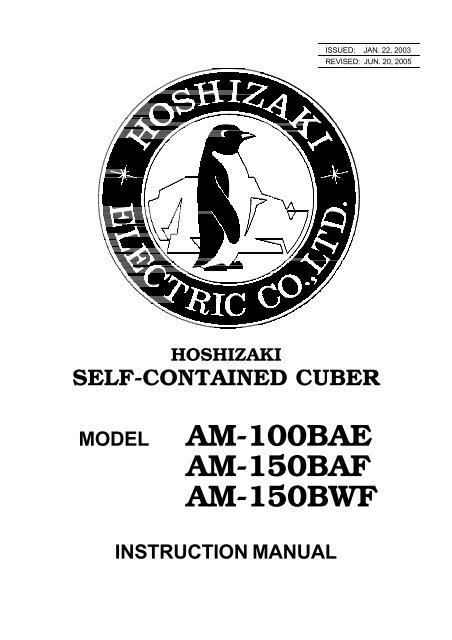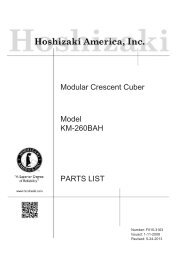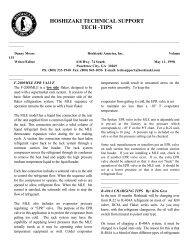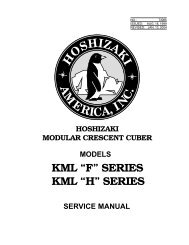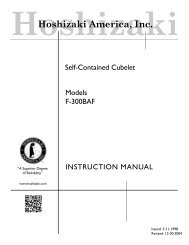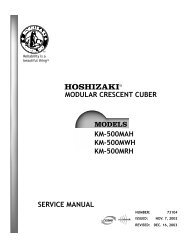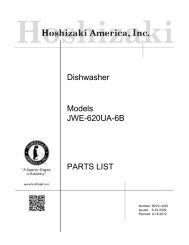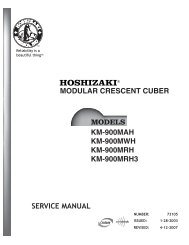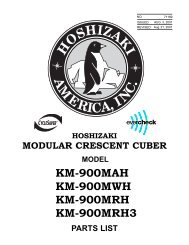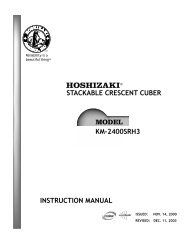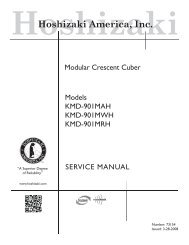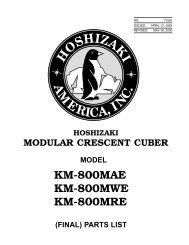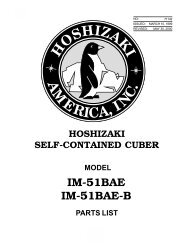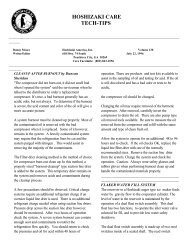Instruction Manual - Hoshizaki America, Inc.
Instruction Manual - Hoshizaki America, Inc.
Instruction Manual - Hoshizaki America, Inc.
Create successful ePaper yourself
Turn your PDF publications into a flip-book with our unique Google optimized e-Paper software.
ISSUED: JAN. 22, 2003<br />
REVISED: JUN. 20, 2005<br />
HOSHIZAKI<br />
SELF-CONTAINED CUBER<br />
MODEL<br />
AM-100BAE<br />
AM-150BAF<br />
AM-150BWF<br />
INSTRUCTION MANUAL
FOREWORD<br />
IMPORTANT<br />
Only qualified service technicians should attempt to install, service or maintain this<br />
icemaker. No such installation, service or maintenance should be undertaken until<br />
the technician has thoroughly read this <strong>Instruction</strong> <strong>Manual</strong>. Likewise, the owner/<br />
manager should not proceed to operate the icemaker until the installer has<br />
instructed them on its proper operation.<br />
HOSHIZAKI provides this manual primarily to assist qualified service technicians in the<br />
installation, maintenance and service of the icemaker.<br />
Should the reader have any questions or concerns which have not been satisfactorily<br />
addressed, please call or write to the HOSHIZAKI Technical Support Department for<br />
assistance.<br />
HOSHIZAKI AMERICA, INC.<br />
618 Highway 74 South<br />
Peachtree City, GA 30269<br />
Attn: HOSHIZAKI Technical Support Department<br />
Phone: 1-800-233-1940 Technical Service<br />
(770) 487-2331<br />
Fax: (770) 487-3360<br />
NOTE: To expedite assistance, all correspondence/communication MUST include the<br />
following information:<br />
• Model Number<br />
• Serial Number<br />
• Complete and detailed explanation of the problem
IMPORTANT<br />
1. This booklet is an integral and essential part of the product and should be<br />
handed over to the user. Read the warnings contained in this booklet carefully<br />
as they give important indications regarding the safety of the installation, use<br />
and maintenance. Please preserve this booklet for any further consultation<br />
that may be necessary.<br />
2. This icemaker should be destined only to the use for which it has been<br />
expressly conceived. Any other use should be considered improper and<br />
therefore dangerous. The manufacturer cannot be held responsible for<br />
eventual damage caused by improper, incorrect and unreasonable use.<br />
CONTENTS<br />
PAGE<br />
I. GENERAL INFORMATION ----------------------------------------------------------------------------1<br />
1. CONSTRUCTION ------------------------------------------------------------------------------------1<br />
[a] AM-100BAE --------------------------------------------------------------------------------------1<br />
[b] AM-150BAF --------------------------------------------------------------------------------------2<br />
[c] AM-150BWF --------------------------------------------------------------------------------------3<br />
II. INSTALLATION AND OPERATING INSTRUCTIONS -------------------------------------------4<br />
1. CHECKS BEFORE INSTALLATION ------------------------------------------------------------4<br />
2. LOCATION --------------------------------------------------------------------------------------------5<br />
3. SET UP ------------------------------------------------------------------------------------------------6<br />
4. ELECTRICAL CONNECTIONS ------------------------------------------------------------------6<br />
5. WATER SUPPLY AND DRAIN CONNECTIONS ---------------------------------------------7<br />
6. FINAL CHECK LIST ---------------------------------------------------------------------------------9<br />
7. START UP ---------------------------------------------------------------------------------------------9<br />
8. PREPARING THE ICEMAKER FOR LONG STORAGE (more than 1 day) ---------- 10<br />
III. MAINTENANCE AND CLEANING INSTRUCTIONS ----------------------------------------- 12<br />
1. CLEANING INSTRUCTIONS -------------------------------------------------------------------- 12<br />
[a] WATER SYSTEM------------------------------------------------------------------------------ 12<br />
[b] STORAGE BIN, SLOPE, SCOOP, ETC.------------------------------------------------- 13<br />
2. MAINTENANCE------------------------------------------------------------------------------------ 16<br />
SERVICE INSTRUCTIONS ---------------------------------------------------------------------------- 17
I. GENERAL INFORMATION<br />
1. CONSTRUCTION<br />
[a] AM-100BAE<br />
Top Panel<br />
Front Panel (Upper)<br />
Ice Making Mechanism<br />
Bin Control Thermostat<br />
Storage Bin<br />
Slope<br />
Door<br />
Front Panel (Lower)<br />
Control Box<br />
Condenser<br />
Air Filter<br />
Tapped Hole (Leg Mounting)<br />
Control Switch<br />
Fuse<br />
1
[b] AM-150BAF<br />
Top Panel<br />
Ice Making Mechanism<br />
Separator<br />
Water Tank<br />
Bin Control Thermostat<br />
Slope<br />
Door<br />
Storage Bin<br />
Front Panel (Lower)<br />
Control Box<br />
Condenser<br />
Air Filter<br />
Tapped Hole (Leg Mounting)<br />
Control Switch<br />
Fuse<br />
2
[c] AM-150BWF<br />
Top Panel<br />
Ice Making Mechanism<br />
Separator<br />
Water Tank<br />
Bin Control Thermostat<br />
Slope<br />
Door<br />
Storage Bin<br />
Front Panel (Lower)<br />
Control Box<br />
Condenser<br />
Tapped Hole (Leg Mounting)<br />
Control Switch<br />
Fuse<br />
3
II. INSTALLATION AND OPERATING INSTRUCTIONS<br />
1. CHECKS BEFORE INSTALLATION<br />
* Visually inspect the exterior of the shipping container, and any severe damage noted should<br />
be reported to the carrier.<br />
WARNING<br />
1. Remove shipping tape(s) and packing as follows. If any left in the icemaker,<br />
it will not work properly.<br />
2. Do not lift or carry the unpacked icemaker by using the brass fitting for water<br />
supply at the rear of the unit. The plastic threads may be damaged.<br />
IMPORTANT<br />
1. Remove the shipping tapes holding the Door and Separator.<br />
2. Ensure all components, fasteners and thumbscrews are securely in place.<br />
* Remove the package containing accessories.<br />
* Check that refrigerant lines do not rub or touch lines or other surfaces.<br />
* Check that the Compressor is snug on all mounting pads.<br />
* See the Nameplate on the upper right part of the Left Side Panel, and check that your<br />
voltage supplied corresponds with the voltage specified on the Nameplate.<br />
Ice Making Mechanism<br />
Separator<br />
Nameplate<br />
Shipping Tape<br />
Door<br />
Shipping Tape<br />
Accessories<br />
Compressor<br />
Mounting Pad<br />
Fig. 1<br />
4
2. LOCATION<br />
WARNING<br />
This icemaker is not intended for outdoor use. Normal operating ambient<br />
temperature should be within 50°F (10°C) to 100°F (38°C); Normal operating<br />
water temperature should be within 41°F (5°C) to 90°F (32°C). Operation of<br />
the icemaker, for extended periods, outside of these normal temperature ranges<br />
may affect production capacity.<br />
For best operating results:<br />
* The icemaker should not be located next to ovens, grills or other high heat producing<br />
equipment.<br />
* The location should provide a firm foundation for the equipment. Level the icemaker from<br />
side to side and front to rear.<br />
* Avoid a site where dripping is not allowed.<br />
* This icemaker will not work at subfreezing temperatures. To prevent damage to the water<br />
supply line, drain the icemaker when air temperature is below zero.<br />
* The AM-100BAE icemaker requires no clearance at either side. But allow enough space<br />
at rear for water supply and drain connections, at least 12” (approx. 30 cm) clearance at<br />
front, and at least 0.6” (approx. 15 mm) clearance at top for maintenance.<br />
* The AM-150BAF icemaker requires 2” (approx. 5 cm) clearance at either side. Allow enough<br />
space at rear for water supply and drain connections, at least 12” (approx. 30 cm) clearance<br />
at front, and at least 0.6” (approx. 15 mm) clearance at top for maintenance.<br />
5
3. SET UP<br />
IMPORTANT<br />
Do not place heavy objects exceeding 33 lbs (15 kg) on the Top Panel.<br />
1) Unpack the icemaker, and remove all shipping cartons, tapes<br />
and packing BEFORE operating the unit.<br />
2) Position the icemaker in a selected site. Clean the interior<br />
with soap and water and rinse thoroughly.<br />
3) Level the icemaker in both the left-to-right and the front-torear<br />
directions (when installed with or without legs). See Fig.<br />
2.<br />
4) When installing the unit without legs, the perimeter where the<br />
machine touches the counter should be sealed with silicone<br />
to prevent water from leaking under the icemaker.<br />
5) When installing the unit with legs on the bottom, use the four<br />
accessory legs adjustable from 6” (15.2 cm) to 7” (17.8 cm).<br />
Screw the legs tightly into the tapped holes in the base (see<br />
Fig. 3). Handle the icemaker carefully not to damage the<br />
exterior.<br />
4. ELECTRICAL CONNECTIONS<br />
Fig. 2<br />
Fig. 3<br />
Max. 0.4” (1 cm)<br />
Tapped Hole<br />
(Leg Mounting)<br />
Base<br />
Adjustable Leg<br />
WARNING<br />
THIS APPLIANCE MUST BE GROUNDED.<br />
This icemaker requires a ground that meets the national and local electrical<br />
code requirements. To prevent possible severe electrical shock injury to<br />
individuals or extensive damage to equipment, install a proper ground wire to<br />
this icemaker. Remove the plug from the mains socket before any maintenance,<br />
repairs or cleaning is undertaken.<br />
* This icemaker must be plugged into the separated power receptacle which has enough<br />
capacity. The maximum allowable voltage variation should not exceed ± 10 percent of the<br />
nameplate rating. See the Nameplate.<br />
* Usually an electrical permit and services of a licensed electrician are required.<br />
6
5. WATER SUPPLY AND DRAIN CONNECTIONS<br />
WARNING<br />
To prevent damage to the freezer mechanism, do not operate this icemaker<br />
when the water supply is OFF, or if the pressure is below 10 PSIG (0.7 bar), the<br />
recommended water pressure. Stop the icemaker until proper water pressure<br />
is resumed.<br />
CAUTION<br />
1. A brass fitting for the water supply line connection is attached to the 3/4” BSP<br />
plastic threads to avoid cross-threading of the Water Valve possibly resulting<br />
in leaks. The brass fitting allows connection of a 1/2” FPT that should be<br />
connected to the potable water supply line.<br />
2. While making the water supply line connection, use a wrench to hold the<br />
brass fitting still to prevent overtightening and damage to the plastic threads.<br />
* Water supply inlet for the icemaker is 1/2” female pipe thread (FPT).<br />
Note: On water-cooled model, two water supply inlets are provided. One is for the icemaker<br />
(1/2” FPT), and the other is for the water-cooled condenser (1/2” FPT).<br />
* The brass fitting is attached as shown in Fig. 4. The fitting size is a 1/2” FPT and must be<br />
connected only to a potable water supply.<br />
* A water supply line shut-off valve and drain valve must be installed.<br />
* Water supply pressure should be a minimum of 10 PSIG (0.7 bar) and a maximum of 113<br />
PSIG (7.5 bar). If the pressure exceeds 113 PSIG (7.5 bar), use a pressure reducing valve.<br />
* Drain outlet for icemaker dump is 3/4” FPT.<br />
Note: On water-cooled model, a 3/8” FPT is provided for the condenser drain outlet. The<br />
icemaker drain and the condenser drain piping connections must be made separately.<br />
* Drain must be 1/4” fall per foot (2 cm fall per meter) on horizontal runs to get good flow.<br />
* Keep a more than 2 vertical inch (5 vertical cm) air gap between the drain pipe end and the<br />
sink.<br />
* The drain pipe must be so laid as to prevent a backflow into the Storage Bin. Provide a trap<br />
in the bin drain line to prevent odor from flowing back into the Storage Bin.<br />
7
* A plumbing permit and services of a licensed plumber may be required in some areas.<br />
* This icemaker should be installed in accordance with applicable national, state and local<br />
regulations.<br />
AM-100BAE<br />
AM-150BAF<br />
Icemaker<br />
Water Supply Inlet<br />
3/4” BSP Threads<br />
Brass fitting is attached<br />
to Water Supply Inlet.<br />
Fitting size is a 1/2” FPT.<br />
Shut-off Valve<br />
Trap<br />
1/4” fall per foot<br />
Drain Valve<br />
Bin Drain Outlet<br />
3/4” FPT<br />
To approved floor drain<br />
AM-150BWF<br />
Condenser Outlet<br />
3/8” FPT<br />
Water-cooled<br />
Condenser Inlet<br />
1/2” FPT<br />
Icemaker<br />
Water Supply Inlet<br />
3/4” BSP Threads<br />
Brass fitting is attached<br />
to Water Supply Inlet.<br />
Fitting size is a 1/2” FPT.<br />
Shut-off Valve<br />
Drain Valve<br />
Bin Drain Outlet 3/4” FPT<br />
1/4” fall per foot<br />
Drain Valve<br />
To approved floor drain<br />
Shut-off Valve<br />
Fig. 4<br />
8<br />
Trap
6. FINAL CHECK LIST<br />
1) Is the icemaker level?<br />
2) Is the icemaker in a site where the ambient temperature is within 50°F (10°C) to 100°F<br />
(38°C) and the water temperature within 41°F (5°C) to 90°F (32°C) all year around?<br />
3) Have all shipping tape(s), string and packing been removed from the icemaker?<br />
4) Are all components, fasteners and thumbscrews securely in place?<br />
5) Have all electrical and piping connections been made?<br />
6) Has the power supply voltage been tested or checked against the nameplate rating?<br />
Has a proper earth been installed to the icemaker?<br />
7) Are the Water Supply Line Shut-off Valve and Drain Valve installed? Has the water supply<br />
pressure been checked to ensure a minimum of 10 PSIG (0.7 bar) and a maximum of<br />
113 PSIG (7.5 bar)?<br />
8) Have the Compressor hold-down bolts and all refrigerant lines been checked against<br />
vibration and possible failure?<br />
9) Has the Bin Control Thermostat been checked for correct operation? When the icemaker<br />
is running, cool the Detector of the Bin Control Thermostat. The icemaker should stop<br />
within 10 seconds.<br />
10) Has the user been given the <strong>Instruction</strong> <strong>Manual</strong> and instructed on how to operate the<br />
icemaker and the importance of periodic maintenance recommended?<br />
11) Has the user been given the name and telephone number of the Authorized Service<br />
Agency?<br />
7. START UP<br />
* Check that shipping tape(s), string and packing are removed before starting the icemaker.<br />
1) Clean inside the Storage Bin and Door.<br />
2) Open the Water Supply Line Shut-off Valve and plug in the icemaker.<br />
3) Remove the Front Panel (Lower), and move the Control Switch on the Control Box to the<br />
“ICE” position.<br />
* The freezing cycle will start automatically.<br />
9
8. PREPARING THE ICEMAKER FOR LONG STORAGE (more than 1<br />
day)<br />
WARNING<br />
Drain the icemaker to prevent damage to the water supply line at subfreezing<br />
temperatures, using air or carbon dioxide. Shut off the icemaker until proper air<br />
temperature is resumed.<br />
[1] On water-cooled model only, first remove the water from the water-cooled condenser:<br />
1) Remove the Front Panel (Lower).<br />
2) Move the Control Switch, on the Control<br />
Box, to the “OFF” position.<br />
3) Wait 3 minutes.<br />
4) Move the Control Switch to the “ICE”<br />
position.<br />
Icemaker<br />
Potable Water<br />
Supply Line<br />
Shut-off Valve<br />
5) Allow 5 minutes for the icemaker to fill with<br />
water and the Water Pump to start<br />
operating.<br />
6) Close the Water-cooled Condenser<br />
Water Supply Line Shut-off Valve.<br />
Water-cooled Condenser<br />
Water Supply Line<br />
Air or CO2<br />
Drain Valve<br />
Shut-off Valve<br />
7) Open the Drain Valve for the water-cooled<br />
condenser water supply line.<br />
8) Allow the line to drain by gravity.<br />
Air or CO2<br />
Fig. 5<br />
Drain Valve<br />
9) Attach compressed air or carbon dioxide supply to the Condenser Water Line Drain<br />
Valve.<br />
10) Blow the water-cooled condenser out using compressed air or carbon dioxide until water<br />
stops coming out.<br />
[2] Remove the water from the potable water supply line and the Water Tank:<br />
1) Close the Water Supply Line Shut-off Valve, and open the Drain Valve.<br />
2) Remove the Front Panel (Lower), and move the Control Switch, on the Control Box, to the<br />
“OFF” position.<br />
10
3) Blow out the water supply line.<br />
Note: This procedure is necessary to protect the icemaker from freezing up at subfreezing<br />
temperature.<br />
4) Unplug the icemaker.<br />
5) Remove all ice from the Storage Bin, and clean the Bin.<br />
6) Drain and clean the Water Tank. See “III. 1. [b] STORAGE BIN, SLOPE, SCOOP, ETC.”<br />
7) Refit the Front Panel (Lower) in its correct position.<br />
8) Close the Drain Valve.<br />
11
III. MAINTENANCE AND CLEANING INSTRUCTIONS<br />
IMPORTANT<br />
Ensure all components, fasteners and thumbscrews are securely in place after<br />
any maintenance or cleaning is done to the equipment.<br />
1. CLEANING INSTRUCTIONS<br />
WARNING<br />
1. HOSHIZAKI recommends cleaning this unit at least once a year. More<br />
frequent cleaning, however, may be required in some existing water conditions.<br />
2. To prevent injury to individuals and damage to the icemaker, do not use<br />
ammonia type cleaners.<br />
3. Always wear liquid-proof gloves for safe handling of the cleaning and sanitizing<br />
solutions. This will prevent irritation in case the solution comes into contact<br />
with skin.<br />
[a] WATER SYSTEM<br />
1) Dilute approximately 5 fl. oz. (148 ml) of recommended cleaner <strong>Hoshizaki</strong> “Scale Away”<br />
or “LIME-A-WAY” (Economics Laboratory, <strong>Inc</strong>.) with 1 gal. (3.8 lit.) of water.<br />
2) Remove all ice from the Evaporator and the Storage Bin.<br />
Note: To remove cubes on the Evaporator, remove the Front Panel (Lower), move the<br />
Control Switch on the Control Box to the “OFF” position and move it back to the<br />
“ICE” position after 3 minutes. The defrost cycle starts and the cubes will be<br />
removed from the Evaporator.<br />
3) Move the Control Switch to the “OFF” position. Close the Water Supply Line Shut-off<br />
Valve.<br />
4) Remove the Water Tank to drain the water. Refit the Water Tank in its correct position.<br />
5) Slowly pour the cleaning solution into the Water Tank.<br />
6) Move the Control Switch to the “WASH” position.<br />
7) After circulating the cleaning solution for about 30 minutes, move the Control Switch to the<br />
“OFF” position.<br />
12
8) Remove the Water Tank to drain the cleaning solution. Refit the Water Tank in its correct<br />
position.<br />
9) Open the Shut-off Valve.<br />
10) Move the Control Switch to the “WASH” position to circulate clean water for about 5<br />
minutes.<br />
11) Move the Control Switch to the “OFF” position and immediately back to the “WASH”<br />
position to rinse water.<br />
12) Repeat the above rinse procedure three more times to rinse thoroughly.<br />
13) Dilute approximately 0.5 fl. oz. (14.8 ml) of 5.25% Sodium Hypochlorite (Chlorine Bleach)<br />
with 1 gal. (3.8 lit.) of water.<br />
14) Move the Control Switch to the “OFF” position. Close the Water Supply Line Shut-off<br />
Valve.<br />
15) Remove the Water Tank to drain the water. Refit the Water Tank in its correct position.<br />
16) Slowly pour the sanitizing solution into the Water Tank.<br />
17) Move the Control Switch to the “WASH” position.<br />
18) After circulating the sanitizing solution for about 15 minutes, move the Control Switch to<br />
the “OFF” position.<br />
19) Remove the Water Tank to drain the sanitizing solution. Refit the Water Tank in its correct<br />
position.<br />
20) Open the Shut-off Valve.<br />
21) Move the Control Switch to the “WASH” position to circulate clean water for about 5<br />
minutes.<br />
22) Move the Control Switch to the “OFF” position and immediately back to the “WASH”<br />
position to rinse water.<br />
23) Repeat the above rinse procedure two more times to rinse thoroughly.<br />
24) Move the Control Switch to the “ICE” position, and start the automatic icemaking process.<br />
Refit the Front Panel (Lower) in its correct position.<br />
13
[b] STORAGE BIN, SLOPE, SCOOP, ETC.<br />
IMPORTANT<br />
1. Wash your hands before removing ice. Use the Plastic Scoop provided to<br />
remove ice.<br />
2. Keep the Scoop clean. Clean it by using a neutral cleaner at least once a<br />
day, and rinse thoroughly.<br />
3. Close the Bin Door after removing ice to prevent entrance of dirt, dust or<br />
insects into the Bin.<br />
4. Clean the Bin Liner at least once a month by using a neutral cleaner. Rinse<br />
thoroughly after cleaning.<br />
5. The Storage Bin is for ice use only. Do not store anything else in the Bin.<br />
6. Keep the area around the icemaker clean. Dirt, dust or insects in the icemaker<br />
could cause electrical damage to the equipment or harm to individuals.<br />
1) Remove the Front Panel (Lower), and move the Control Switch on the Control Box to the<br />
“OFF” position.<br />
2) Unplug the icemaker.<br />
3) Open the Bin Door, and remove ice from the Storage Bin.<br />
4) Remove the Slope by bending its center carefully and releasing it from the two Slope<br />
Shafts. Take out the Slope from the Storage Bin.<br />
5) Thoroughly clean and sanitize the Storage Bin, Slope, Scoop and any parts normally<br />
accessible from the Storage Bin.<br />
6) Remove each Separator by lifting it to the<br />
horizontal position and pushing it hard inward.<br />
Remove all the Separators in the same way,<br />
and clean and sanitize them.<br />
Separator<br />
7) Disconnect the Suction Tube from the Water<br />
Tank to drain the Tank.<br />
Water Tank<br />
Suction Tube<br />
14
8) Remove the Thumbscrews on both sides of the<br />
Water Tank, and pull it out toward you. Clean<br />
and sanitize the Water Tank.<br />
Water Tank<br />
Thumbscrew<br />
9) Pull the Discharge Tube from the Water Plate.<br />
Remove the Water Plate by pulling it toward you.<br />
Water Plate<br />
Discharge Tube<br />
10) Remove the Caps to clean and sanitize the<br />
Water Plate. If the Nozzles are clogged, clean<br />
them with a wire or a suitable brush.<br />
Cap<br />
Water Plate<br />
11) Refit the Caps on the Cleaning Outlets to seal<br />
them off.<br />
Cap<br />
Water Plate<br />
12) Slide in the Water Plate along the Mechanism<br />
Base. Refit the Discharge Tube securely on<br />
the Spray Outlet. A loose fitting may cause a<br />
water leak.<br />
Water Plate<br />
13) Place the rear of the Water Tank on the Water<br />
Tank Rest at the back of the Storage Bin. Use<br />
the Thumbscrews to secure the front of the<br />
Water Tank to the Mechanism Base.<br />
Mechanism Base<br />
Discharge Tube<br />
Bin Rear<br />
Tank Rest<br />
Thumbscrew<br />
Water Tank<br />
14) Refit the Suction Tube on to the Water Tank Inlet.<br />
A loose fitting may cause a water leak.<br />
Water Tank<br />
Suction Tube<br />
15
15) Hook each Separator on to the Mechanism<br />
Base, and pull it hard toward you until it locks in<br />
place with a click. Refit all the Separators in<br />
the same way.<br />
Separator<br />
16) Refit the Slope in its correct position.<br />
17) Plug in the icemaker, and move the Control Switch on the Control Box to the “ICE” position<br />
to start the automatic icemaking process.<br />
18) Refit the Front Panel (Lower) in its correct position.<br />
2. MAINTENANCE<br />
IMPORTANT<br />
This icemaker must be maintained individually, referring to the instruction manual<br />
and labels provided with the icemaker.<br />
1) Exterior<br />
2) Air Filter<br />
To keep the exterior clean, wipe occasionally with a clean and soft cloth. Use a damp<br />
cloth containing a neutral cleaner to wipe off all oil or dirt build-up.<br />
A plastic mesh air filter removes dirt or dust from the air, and keeps the Condenser<br />
from getting clogged. As the filter gets clogged, the icemaker’s performance will be<br />
reduced. Check the filter at least twice a month. When clogged, use warm water and<br />
a neutral cleaner to wash the filter.<br />
3) Condenser<br />
Check the Condenser once a year, and clean if required by using a brush or vacuum<br />
cleaner. More frequent cleaning may be required depending on the location of the<br />
icemaker.<br />
16
SERVICE INSTRUCTIONS<br />
Bin Control Thermostat Replacement Procedure<br />
To ensure proper operation, follow the instructions below:<br />
[AM-100BAE]<br />
1) Make a 40 mm (1.6”) diameter loop.<br />
2) Locate the loop below the Thermostat<br />
Capillary (Bulb).<br />
3) <strong>Manual</strong>ly bend the Capillary to keep it<br />
15 mm (0.6”) forward from the through<br />
hole position on the Holder.<br />
[AM-150BAF/BWF]<br />
1) Make a 40 mm (1.6”) ID U-bend.<br />
2) Locate the U-bend 60 mm (2.4”) below<br />
the Thermostat Capillary (Bulb).<br />
3) <strong>Manual</strong>ly bend the Capillary to keep it<br />
15 mm (0.6”) forward from the through<br />
hole position on the Holder.<br />
4) Turn up the end of the Capillary.<br />
Through Hole<br />
Holder<br />
4) Turn up the end of the Capillary.<br />
Through Hole<br />
Bracket - Holder<br />
Holder<br />
Capillary (Bulb)<br />
End<br />
Loop<br />
15 mm (0.6”)<br />
60 mm (2.4”)<br />
Capillary (Bulb)<br />
End<br />
40 mm (1.6”) DIA<br />
Capillary (Bulb)<br />
15 mm (0.6”)<br />
40 mm (1.6”)<br />
Capillary (Bulb)<br />
Bin Control Thermostat Assembly Details<br />
Thermostat<br />
A<br />
Silicone Tube<br />
Silicone Tube<br />
Seal<br />
150mm<br />
(5.9”)<br />
210mm (8.3”)<br />
Cord Heater<br />
Flexible Tube<br />
DETAIL A<br />
[NOTE]<br />
1) Run Cord Heater along with Capillary of Thermostat and bind them tightly with<br />
Aluminum Tape (Form end to end of Cord Heater).<br />
2) Do not overheat Flexible Tube during shrinking process.<br />
17<br />
Capillary (Bulb)
HOSHIZAKI AMERICA, INC.<br />
618 HIGHWAY 74 SOUTH<br />
PEACHTREE CITY, GA 30269<br />
U.S.A.<br />
PHONE: 770-487-2331<br />
www.hoshizakiamerica.com<br />
9117EA10H


